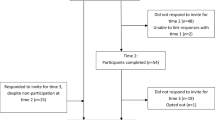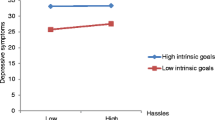Abstract
University students have reported that they engage increasingly in more financial economizing behaviors to cope with limited resources, often to the detriment of their well-being. The objectives of this study were to investigate the mediating role of perceived financial strain between economizing behaviors and depressed mood and life satisfaction, and to compare this mediator model to the prevailing direct effects model currently reflected in the literature. Using structural equation modelling, latent-variable mediation analysis supported the notion that economizing behaviors significantly, but indirectly, predict greater depressed mood and lower life satisfaction through perceived financial strain. When examined using non-hierarchical model comparison indices, the mediation model was a superior fit to the data, compared to the direct effects model.



Similar content being viewed by others
Notes
In Australia, a tertiary student is any individual enrolled in a post-secondary diploma or degree program at an educational institution, such as a university or technical college.
Model fit statistics did not differ significantly when fitting the model using a sample with postgraduate students removed (χ 2 (40, N = 576) = 87.77, p < .001, χ 2/df = 2.19, CFI = .97, RMSEA = .05 (90 % CI .03–.06), AIC = 139.77, BIC = 253.02). Further, pathways coefficients did not differ significantly between the models. Consequently, postgraduate students were retained in the sample.
References
Allison, P. D. (2003). Missing data techniques for structural equation modeling. Journal of Abnormal Psychology, 112(4), 545–557. doi:10.1037/0021-843X.112.4.545.
Anderson, J. C., & Gerbing, D. W. (1988). Structural equation modeling in practice: A review and recommended two-Step approach. Psychological Bulletin, 103(3), 411–423. doi:10.1037/0033-2909.103.3.411.
Angel, R. J., Frisco, M., Angel, J. L., & Chiriboga, D. A. (2003). Financial strain and health among elderly Mexican-origin individuals. Journal of Health and Social Behavior, 44(4), 536–551. Retrieved from http://www.jstor.org/stable/1519798?origin=JSTOR-pdf.
Arbuckle, J. L. (2008). AMOS 17 User’s Guide. Chicago: SPSS Inc.
Arnett, J. J. (2000). Emerging adulthood: A theory of development from the late teens through the twenties. American Psychologist, 55(5), 469–480. doi:10.1037//0003-066X.55.5.469.
Australian Bureau of Statistics. (2009). Australian Social Trends (No. 4102.0). Retrieved from http://www.abs.gov.au/ausstats/abs@.nsf/mf/4102.0.
Australian Bureau of Statistics. (2012). Year Book Australia (No. 1301.0). Retrieved from http://www.abs.gov.au/ausstats/abs@.nsf/mf/1301.0.
Australian Bureau of Statistics. (2013). Australian Social Trends (No. 4102.0). Retrieved from http://www.abs.gov.au/ausstats/abs@.nsf/mf/4102.0.
Bacikova-Sleskova, M., Dijk, J. P., Geckova, A. M., Nagyova, I., Salonna, F., Reijneveld, S. A., et al. (2007). The impact of unemployment on school leavers’ perception of health. Mediating effect of financial situation and social contacts? International Journal of Public Health, 52(3), 180–187. doi:10.1007/s00038-007-6071-4.
Bexley, E., Daroesman, S., Arkoudis, S., & James, R. (2013). University student finances in 2012: A study of the financial circumstances of domestic and international students in Australia’s universities. Canberra: Australian Vice-Chancellors’ Committee.
Boddington, L., & Kemp, S. (1999). Student debt, attitudes towards debt, impulsive buying, and financial management. New Zealand Journal of Psychology, 28(2), 89–93. Retrieved from http://www.psychology.org.nz/cms_show_download.php?id=720.
Borden, L. M., Lee, S. A., Serido, J., & Collins, D. (2008). Changing college students’ financial knowledge, attitudes, and behavior through seminar participation. Journal of Family and Economic Issues, 29(1), 23–40. doi:10.1007/s10834-007-9087-2.
Bradley, G. (2006). Work participation and academic performance: A test of alternative propositions. Journal of Education and Work, 19(5), 481–501. doi:10.1080/13639080600988756.
Bradley, D., Noonan, P., Nugent, H., & Scale, B. (2008). Review of Australian higher education: Final report. Canberra: Department of Education, Employment and Workplace Relations.
Brougham, R. R., Zail, C. M., Mendoza, C. M., & Miller, J. R. (2009). Stress, sex differences, and coping strategies among college students. Current Psychology: A Journal for Diverse Perspectives on Diverse Psychological Issues, 28(2), 85–97. doi:10.1007/s12144-009-9047-0.
Burnham, K. P., & Anderson, D. R. (2004). Multimodel inference: Understanding AIC and BIC in model selection. Sociological Methods and Research, 33(2), 261–304. doi:10.1177/0049124104268644.
Chou, K. L., Chi, I., & Chow, N. W. (2004). Sources of income and depression in elderly Hong Kong Chinese: mediating and moderating effects of social support and financial strain. Aging & Mental Health, 8(3), 212–221. doi:10.1080/13607860410001669741.
Cohen, S., & Wills, T. A. (1985). Stress, social support, and the buffering hypothesis. Psychological Bulletin, 98(2), 310-357. Retrieved from http://psycnet.apa.org/?&fa=main.doiLanding&uid=1986-01119-001.
Curtis, S., & Shani, N. (2002a). The effect of taking paid employment during term-time on students’ academic studies. Journal of Further and Higher Education, 26(2), 129–137. doi:10.1080/03098770220129406.
Curtis, S., & Shani, N. (2002b). The reluctant workforce: undergraduates’ part-time employment. Education and Training, 44(1), 5–10. doi:10.1108/00400910210416192.
Department of Education, Science and Training. (2009). Students 2006 - Full year. Canberra, ACT: Department of Education, Science and Training.
Department of Industry, Innovation, Climate Change, Science, Research and Tertiary Education. (2009). Full year student summary. Canberra, ACT: Innovation.
Dunn, N., Inskip, H., Kendrick, T., Oestmann, A., Barnett, J., Godfrey, K., et al. (2008). Does perceived financial strain predict depression among young women? Longitudinal findings from the Southampton women’s survey. Mental Health in Family Medicine, 5(1), 15-21. Retrieved from http://www.ncbi.nlm.nih.gov/pmc/articles/PMC2777551/pdf/MHFM-05-015.pdf.
Gerrans, P., Speelman, C., & Campitelli, G. (2013). The relationship between personal financial wellness and financial wellbeing: a structural equation modelling approach. Journal of Family and Economic Issues. Advance online publication. doi:10.1007/s10834-013-9358-z.
Hansen, W. L., & Rhodes, M. S. (1988). Student debt crisis: Are students incurring excessive debt? Economics of Education Review, 7(1), 101–112. doi:10.1016/0272-7757(88)90075-1.
Hayes, A. F. (2009). Beyond Baron and Kenny: Statistical mediation analysis in the new millennium. Communication Monographs, 76(4), 408–420. doi:10.1080/03637750903310360.
Hu, L. T., & Bentler, P. M. (1999). Cutoff criteria for fit indexes in covariance structure analysis: Conventional criteria versus new alternatives. Structural Equation Modeling, 6(1), 1–55. doi:10.1080/10705519909540118.
Hunt, A., Lincoln, I., & Walker, A. (2004). Term-time employment and academic attainment: evidence from a large-scale survey of undergraduates at Northumbria University. Journal of Further and Higher Education, 28(1), 3–18. doi:10.1080/0309877032000161788.
James, R., Bexley, E., Devlin, M., & Marginson, S. (2007). Australian university student finances 2006: final report of a national survey of students in public universities. Canberra: Australian Vice-Chancellors’ Committee.
Kahn, J. R., & Pearlin, L. I. (2006). Financial strain over the life course and health among older adults. Journal of Health and Social Behavior, 47(1), 17–31. doi:10.1177/002214650604700102.
Khawaja, N. G., & Dempsey, J. (2008). A comparison of international and domestic tertiary students in Australia. Australian Journal of Guidance & Counselling, 18(1), 30–46. doi:10.1375/ajgc.18.1.30.
Kirby, D., & Conlon, M. (2005). Comparing the economic experiences of rural and urban university students. Alberta Journal of Educational Research, 51(1), 4–17. Retrieved from http://www.education.ualberta.ca/educ/journals/ajer.html.
Kline, R. B. (2005). Principles and practices of structural equation modeling (2nd ed.). New York: The Guildford Press.
Kuha, J. (2004). AIC and BIC: Comparisons of assumptions and performance. Sociological Methods and Research, 33(2), 188–229. doi:10.1177/0049124103262065.
Lazarus, R. S., & Folkman, S. (1984). Stress, appraisal and coping. New York: Springer Publication Company.
Lucas, R., & Lamont, N. (1998). Combining work and study: an empirical study of full-time students in school, college and university. Journal of Education and Work, 11(1), 41–56.
MacKinnon, D. P., Lockwood, C. M., & Williams, J. (2004). Confidence limits for the indirect effect: Distribution of the product and resampling methods. Multivariate Behavioral Research, 39(1), 99–128. doi:10.1207/s15327906mbr3901_4.
Mattsson, M., Topor, A., Cullberg, J., & Forsell, Y. (2008). Association between financial strain, social network and five-year recovery from first episode psychosis. Social Psychiatry and Psychiatric Epidemiology, 43(12), 947–952. doi:10.1007/s00127-008-0392-3.
Metcalf, H. (2003). Increasing inequality in higher education: The role of term-time working. Oxford Review of Education, 29(3), 315–329. Retrieved from http://www.jstor.org/stable/3595444.
Metcalf, H. (2005). Paying for unversity: The impact of increasing costs on student employment, debt and satisfaction. National Institute Economic Review, 191, 106–117. doi:10.1177/0027950105052662.
Mistry, R. S., Benner, A. D., Tan, C. S., & Kim, S. Y. (2009). Family economic stress and academic well-being among Chinese-American youth: The influence of adolescents’ perceptions of economic strain. Journal of Family Psychology, 23(3), 279–290. doi:10.1037/a0015403.
Monks, J. (2001). Loan burdens and educational attainment. Economics of Education Review, 20, 545–550. doi:10.1016/S0272-7757(00)00030-3.
Morra, D. J., Regehr, G., & Ginsburg, S. (2008). Anticipated debt and financial stress in medical students. Medical Teacher, 30(3), 313–315. doi:10.1080/01421590801953000.
Norvilitis, J. M., Merwin, M. M., Osberg, T. M., Roehling, P. V., Young, P., & Kamas, M. M. (2006). Personality factors, money attitudes, financial knowledge, and credit-card debt in college students. Journal of Applied Social Psychology, 36(6), 1395–1413. doi:10.1111/j.0021-9029.2006.00065.x.
Ross, S., Cleland, J., & Macleod, M. J. (2006). Stress, debt and undergraduate medical student performance. Medical Education, 40(6), 584–589. doi:10.1111/j.1365-2929.2006.02448.x.
Scheffer, J. (2002). Dealing with missing data. Research Letters in the Information and Mathematical Sciences, 3, 153–160. Retrieved from http://muir.massey.ac.nz/bitstream/handle/10179/4355/Dealing_with_Missing_Data.pdf?sequence=1.
Schulenberg, J. E., Bryant, A. L., & O’Malley, P. M. (2004). Taking hold of some kind of life: How developmental tasks relate to trajectories of well-being during the transition to adulthood. Development and Psychopathology, 16(4), 1119–1140.
Shim, S., Barber, B. L., Card, N. A., Xiao, J. J., & Serido, J. (2010). Financial socialization of first-year college students: The roles of parents, work, and education. Journal of Youth and Adolescence, 1–14. doi:10.1007/s10964-009-9432-x.
Shim, S., & Serido, J. (2011). Young adults’ financial capability: Arizona pathways to life success for university students, Wave 2. Tucson: The University of Arizona. Retrieved from http://aplus.arizona.edu/Wave-2-Report.pdf.
Shim, S., Xiao, J. J., Barber, B. L., & Lyons, A. C. (2009). Pathways to life success: A conceptual model of financial well-being for young adults. Journal of Applied Developmental Psychology, 30(6), 708–723. doi:10.1016/j.appdev.2009.02.003.
Stein, C. H., Hoffmann, E., Bonar, E. E., Leith, J. E., Abraham,… Fogo, W. R. (2013). The United States economic crisis: Young adults’ reports of economic pressures, financial and religious coping and psychological well-being. Journal of Family and Economic Issues, 34, 200–210. doi:10.1007/s10834-012-9328-x.
Taylor, N. K. (1998). Survey of paid employment undertaken by full-time undergraduates at an established Scottish University. Journal of Further and Higher Education, 22(1), 33–38. doi:10.1080/0309877980220104.
Valentino, S. W., Moore, J. E., Cleveland, M. J., Greenberg, M. T., & Tan, X. (2013). Profiles of financial stress over time using subgroup analysis. Journal of Family and Economic Issues. Advance online publication. doi:10.1007/s10834-012-9345-9.
Watts, C., & Pickering, A. (2000). Pay as you learn: student employment and academic progress. Education and Training, 2(3), 129–134. doi:10.1108/00400910010372670.
Williams, J., & MacKinnon, D. P. (2008). Resampling and distribution of the product methods for testing indirect effects in complex models. Structural Equation Modeling, 15(1), 23–51. doi:10.1080/10705510701758166.
Wray, N., & McCall, L. (2007). Money matters: students’ perceptions of the costs associated with placements. Medical Education, 41(10), 975–981. doi:10.1111/j.1365-2923.2007.02840.x.
Zimmerman, F. J., & Katon, W. (2005). Socioeconomic status, depression disparities, and financial strain: What lies behind the income-depression relationship? Health Economics, 14(12), 1197–1215. doi:10.1002/hec.1011.
Acknowledgments
The research project was approved by the Murdoch University Human Research Ethics Committee (Permit Number: 2008/019) and conforms to the provisions of the Declaration of Helsinki.
Conflict of interest
None of the authors have a conflict of interest regarding the submission of the manuscript for publication in the Journal of Family and Economic Issues.
Author information
Authors and Affiliations
Corresponding author
Rights and permissions
About this article
Cite this article
Watson, S.J., Barber, B.L. & Dziurawiec, S. The Role of Economizing and Financial Strain in Australian University Students’ Psychological Well-Being. J Fam Econ Iss 36, 421–433 (2015). https://doi.org/10.1007/s10834-014-9404-5
Published:
Issue Date:
DOI: https://doi.org/10.1007/s10834-014-9404-5




